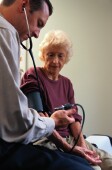
TUESDAY, Jan. 12 (HealthDay News) — Terminally ill patients have much to consider, from whether they want to die at home or in the hospital to whether they want doctors to continue aggressive treatment or focus on making them comfortable during their final weeks or months.
Yet those difficult, emotional conversations aren’t happening nearly as often, or as early, as they ought to be, say researchers who surveyed a national sample of almost 4,100 physicians who treat cancer patients.
Given a hypothetical example of a cancer patient with four to six months to live but who was still feeling well, 65 percent said they would discuss a prognosis. But only 26 percent of doctors said they would discuss hospice with the patient, 21 percent said they would discuss where the patient would like to die and only 44 percent said they would discuss resuscitation preferences.
Instead, some doctors said they would wait until the patient was feeling worse or until there were no more treatment options. That runs counter to current guidelines, which recommend having end-of-life discussions when patients have less than a year to live.
“There are guidelines out there that say if patients are terminal and have a year to live, they should get some information about options for improving the quality of their death,” said lead study author Dr. Nancy Keating, associate professor of medicine and health care policy at Brigham and Women’s Hospital and Harvard Medical School. “This includes their DNR [do not resuscitate] status, hospice enrollment and where they would prefer to die. Most doctors don’t talk to their patients about these things until later than is recommended.”
The study will be published in the Jan. 11 online edition of the journal Cancer.
There are many reasons why doctors aren’t having these discussions as often as they should, said Dr. Len Lichtenfeld, deputy chief medical officer of the American Cancer Society. The conversations can be time consuming and emotionally wrought.
And estimating how long someone has to live is an inexact science. A doctor may have a sense of how long someone has, but an individual patient may die much sooner or later than that, Lichtenfeld said.
“It’s difficult to turn to another human being and say, ‘I think you have six to 12 months to live,'” Lichtenfeld said. “Doctors are trained to save lives. They want to believe, and the patient wants to believe, they are going to be different from the average. Doctors don’t want to take away that hope.”
Not only are doctors treading a fine line between being unnecessarily bleak and giving patients the opportunity to make choices, patients can differ in how much they want to be told. “Some want to know more than others,” Keating said. “The issue is everybody deserves to hear a little about what the options are and how aggressive they want treatments to be.”
Families can be another complicating factor, Lichtenfeld said. Even when patients say they no longer want to continue treatment and instead want only palliative care, heartbroken family members can resist, urging the loved one to keep fighting.
As the nation grapples with reining in health care costs, the survey also raises the issue of doctors offering expensive chemotherapy for terminally ill patients even when there’s little chance it will work, Keating said. Other research has shown that the use of chemotherapy is increasing at the end of life, even for cancers generally considered unresponsive to the drugs, according to background information in the article.
“It may be that doctors are just not comfortable talking about something that is challenging, difficult and time consuming,” Keating said. “It may also be that doctors are not reimbursed for these discussions but they are for ordering another CT scan or round of chemotherapy. The survey suggests to us that doctors may be throwing out another treatment but not helping the patient understand there is no cure.”
Younger physicians were more likely than older physicians to have end-of-life discussions with patients, possibly indicating that current medical training places more emphasis on palliative care.
If doctors don’t bring up end-of-life issues, patients need to bring it up with their physicians, making sure their wishes are known, Keating said. Hospice is comfort-oriented care, most often offered at home, for those who are terminally ill.
More information
The U.S. National Cancer Institute has more on end-of-life care.

